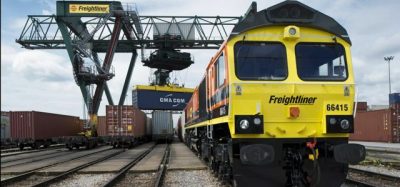Level crossings in Greece: Statistics, analysis and proposed safety measures
Posted: 1 December 2020 | Kostas Kapetanidis, Nikos Kondylas, Stefanos Avdis | No comments yet
Nikos Kondylas, Stefanos Avdis and Kostas Kapetanidis from the Hellenic Railways Organisation (OSE) write about the state of level crossings across the Greek railway network, and the measures being implemented to improve their safety.
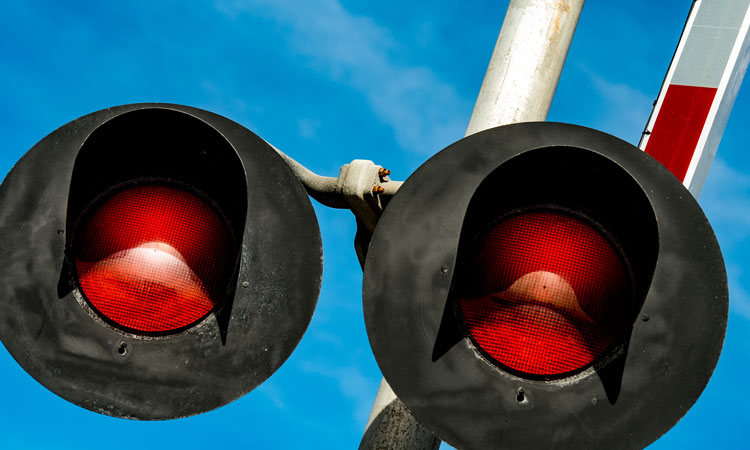

The Greek railway network consists of 2,293km of active line length, some sections of which, such as the Peloponnese metric network, are used only in tourist seasons. The approximate length of the active network in permanent operation reaches 1,800km and is divided into the following sections:
- Main axis (starts from Piraeus, crosses the country, heads north and ends in Thessaloniki)
- Suburban Attica network (Piraeus–Airport and Piraeus–Kiato)
- Western Macedonia (Plati–Florina)
- Eastern Macedonia (Thessaloniki–Alexandroupolis)
- Branches of the main axis (Oinoi–Chalkida, Larissa–Volos, Paleofarsalos–Kalampaka, Lianokladi–Stylida) and of the Western and Eastern Macedonia networks.
According to data from the Network Statements of OSE – the Greek rail infrastructure manager – for 2019, the railway network includes 1,236 level crossings, of which 685 are active and 551 are passive. Compared to 2015, when there were 1,453 level crossings in total (760 active and 693 passive ones), we note a decrease in the number of level crossings by 13 per cent, due to the opening of new sections of the high-speed railway line, with no level crossings at all.
Depending on the way they are protected, level crossings are either characterised as active or as passive. Active level crossings are those that are protected either by an Automatic Level Crossing System (ALCS) or by a guard who manually raises and lowers the bar. Passive level crossings are those that are not protected in any way (unprotected level crossings).
More specifically, in early-2018, the 55km-long Tithorea–Lianokladi section opened to traffic, followed in early-2019 by the 52km-long Lianokladi–Domokos section; the two sections’ total length reached 107km of the high-speed railway connecting Athens with Thessaloniki (with no level crossings). This line is part of the main railway axis of the country, connecting Patras–Athens–Thessaloniki (PATHE). In February 2020, the extensionn of the suburban network of Patras (21km-long section of Agios Andreas–Kato Achaia), with 37 level crossings (all equipped with ALCS), opened to traffic. Finally, in July 2020, the 71km-long Kiato–Aigio section of the Patras–Athens high-speed rail line (part of PATHE), also without any level crossings, opened to traffic.
It is clear that the opening of these large sections of the main PATHE railway axis has resulted in the limitation of existing level crossings and reinforced the safety of rail travel offered.
Geographical distribution and density of level crossings
According to data presented in the European Union Agency for Railways (ERA) study ‘Railway Safety in the EU – Safety overview 2017’, level crossings in Greece exceed the average number in the European Union (EU). More specifically, in Greece, there are 31 unguarded level crossings per 100km of line, whereas in the EU, there are 23 respectively. Also, the corresponding number of ALCS crossings is 34 for Greece and 26 for the EU.
That is, in Greece there are 65 level crossings per 100km, while in the EU there are 49 per 100km.
Concerning Greece, the number of level crossings used for the calculation of the aforementioned indicators (level crossings per 100km), refers to the entire network, including sections that are characterised as active (such as the metric network of Peloponnese), but where only few operate for tourist purposes. Therefore, the number of level crossings in the railway network operating on a regular basis is smaller and is estimated at about 500. Registering level crossings per line section in combination with the length of said section, we calculated the number of level crossings per 100km in the individual sections of the network.
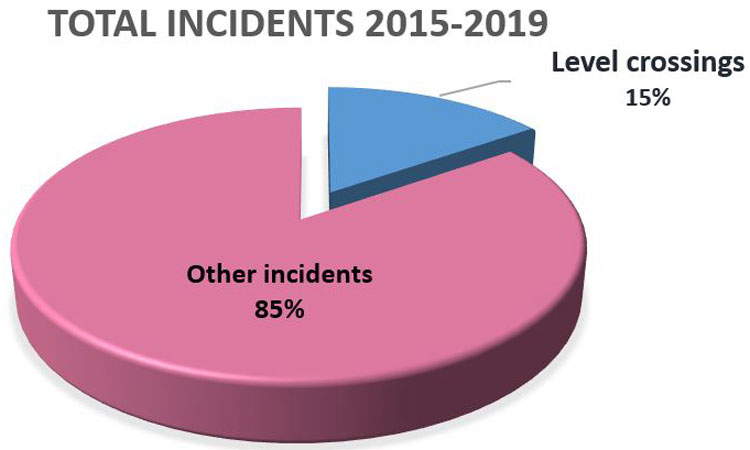

Figure 1: Percentage of incidents at level crossings in relation to total incidents in Greece (Source: ERA-Erail)
Higher level crossing density is noted in sections within urban areas. More specifically, the highest value of the indicator (136 level crossings per 100km) is noted in the Patras suburban network section (Rio–Kato Achaia). The peculiarity of the suburban railway of Patras is that it constitutes a line section being cut off from the high-speed rail line, while it has been operating since 2010 and has a length of 12km. Since February 2020, it is extended from Agios Andreas to Kato Achaia (total length 33km), with very few services and therefore does not constitute a reference point.
The same applies to the Lianokladi–Stylida section, with the second highest value of the indicator (119 level crossings per 100km), a local suburban section (22km) with very few daily services. Therefore, the aforementioned two sections do not constitute a point of reference.
As regards the remaining suburban sections, the approximate indicator value is 50 level crossings per 100km, as shown below:
- Plati–Florina 53 level crossings per 100km
- Oinoi–Chalkida 51 level crossings per 100km
- Paleofarsalos–Kalampaka 50 level crossings per 100km
- Alexandroupoli–Ormenio 49 level crossings per 100km
- Larissa–Volos 49 level crossings per 100km.
Among the high service frequency line sections, the one featuring the largest number (45 level crossings per 100km) is the 71km-long Piraeus–Oinoi section, crossing the urban fabric of Attica from Piraeus to Agios Stefanos. The indicator is very high, especially considering that the specific area is extremely densely populated (about four million residents). The situation is further encumbered by improvised level crossings created by residents or local communities for their service, with a direct impact on security.
In northern Greece, in the Platy–Thessaloniki section (dense urban fabric), the density indicator is at 16 level crossings per 100km, which is lower than the European average. The 44km-long line section Thessaloniki–Alexandroupolis, crossing many cities (section of Thessaloniki, Serres, Drama, Xanthi, Komotini, Alexandroupolis), but mostly extending outside the urban fabric, registers a similar indicator of 15 level crossings per 100km.
Based on the above, we conclude that the situation is better than reflected by official data concerning Greece (i.e. 65 level crossings per 100km) and that real level crossing density numbers are lower. Moreover, it is shown that the problem is mainly detected in the Piraeus–Oinoi section (with a density of 45 level crossings per 100km), on the one hand due to the high service frequency, and on the other due to the fact that it crosses the most densely populated area in Greece. It should be noted here that there is a contract in progress, in the section extending from the RS Athens exit (k.m. 10 + 821) to three Gefyres (k.m. 13 + 180), in the area of Sepolia of the Municipality of Athens, which will make about 1.33 line kilometres underground and will abolish nine of the busiest level crossings in Attica. This project is expected to improve the safety of pedestrians and drivers, as well as benefit traffic in the area.
Level crossings maintenance
The maintenance and damage repair of Automatic Level Crossing Systems is carried out by OSE as the infrastructure manager. Due to the lack of personnel, workshops are usually located in large cities.
When a fault is detected at ALCSs, crews immediately go to repair them. Damage repair times range from about 30 minutes to two hours and the competent technical staff of the ALCSs are on call via mobile phone on a 24-hour basis. In exceptional cases, a longer period of repair time may be required due to extensive damages (theft, vandalism, car collision), or due to a lack of spare parts (specialised or obsolete parts that no longer exist on the market), to be procured or repaired by OSE. In such cases and until damage repair, level crossing storage is provided for, performed by members of the line maintenance departments in charge of the area. If said departments are understaffed, a delay is applied in the trains’ passage from the area of the specific level crossing.
Incidents at level crossings (2015 to 2019)
Based on data for the period 2015-2019, incidents at level crossings constitute one of the most important categories, numerically 15 per cent (see Figure 1). Incidents at level crossings usually result in a collision with a vehicle or pedestrian, leading to deaths and injuries; therefore, we understand that it may be this category that requires the highest attention. The corresponding percentage of incidents at level crossings in relation to total incidents, as regards the members of the International Union of Railways (UIC), reaches 14.6 per cent, according to the UIC Safety Report 2019; therefore, Greece registers a similar percentage with other UIC members (including European countries and Russia, Iran, Turkey and South Korea).
However, this is not the case regarding a vehicle collision incident, or pedestrian incident. Regarding the UIC members, the total percentage (14.6 per cent), comprising 8.7 per cent of incidents with vehicles and 5.9 per cent of incidents with pedestrians. On the contrary, most of the incidents in Greece concern a train collision with a vehicle and not with a pedestrian, as shown in detail in Figure 2, for the years 2015 to 2019.


Figure 2: Incidents with vehicles and pedestrians at Greek level crossings (Source: ERA-Erail)
Significant incidents at level crossings (2015 to 2019)
According to European legislation (2016/798/EC), a railway incident constitutes a significant accident, where at least one railway vehicle in motion is involved and it results in at least one death, or one seriously injured person, or material damage of more than €150,000 or delays of more than six hours on a major railway line. Significant accidents are registered in the annual safety reports of the ERA and are available on the ERAIL (European Railway Accidents Information Links) website.
Figure 3 presents the following data about Greece for the period 2015 to 2019:
- Significant accidents at level crossings per year
- Fatalities at level crossings per year
- Seriously injured persons at level crossings per year.
Regarding the number of serious incidents and fatalities, it is noted that 2015 saw a high number of incidents registered (12), followed by a significant decline in 2016, while in the last three years, there has been a relative stabilisation. Regarding the number of seriously injured persons, it is noted that they ‘follow’ the number of significant accidents and fatalities, with the exception of 2018, when a higher number was registered (7).
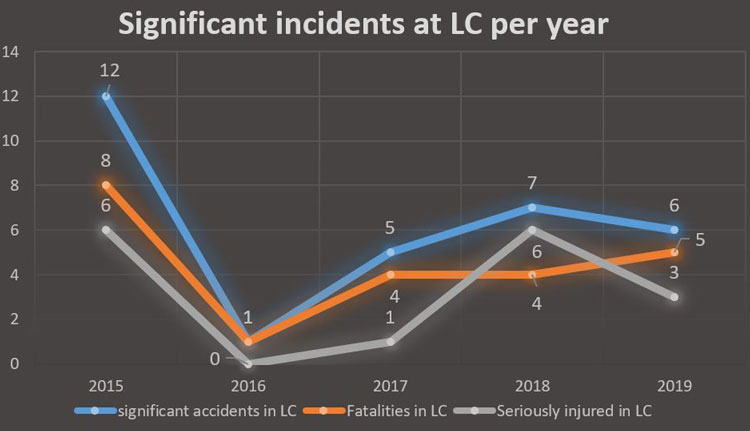

Figure 3: Significant incidents at level crossings per year (Source: ERA-European Railway Accidents Information Links)
Significant incidents per geographic area (2015 to 2019)
Most incidents per area are registered in the Piraeus–Oinoi section, with a total of nine incidents (three deaths and six injured persons). To some extent, this is to be expected considering it is the most densely populated area of the country, with the most frequent services. The Plati– Thessaloniki section comes next, with four incidents in total (three deaths and one injured person), although it has less level crossings per 100km. This is because this section crosses the urban fabric, serves several routes, while there are several refugees in the surrounding area, staying in abandoned rolling stock.
Also in the Plati–Florina section, a total of nine cases, including many deaths, were registered. Five deaths (three of which in two accidents in 2019) is a very large number for a line with few daily itineraries per direction. These incidents are due to the large number of level crossings (most of which are unprotected) and the lack of attention of vehicle drivers. A typical example concerns an incident with a private vehicle driver, who overtook stopped cars at an unprotected crossing, which led to the death of the driver himself as well as his passenger.
A similar line section with very few services per day but with several incidents, is the Alexandroupoli–Ormenio section, where a total of three incidents are registered (two deaths and one injured person).
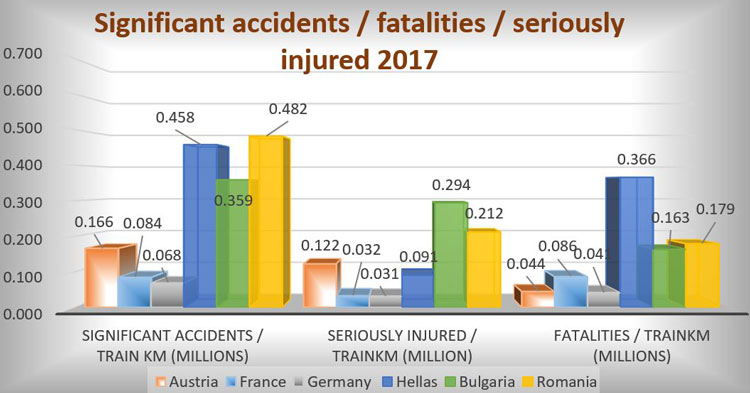

Figure 4: Significant accidents / fatalities / seriously injured 2017 (Source: ERA-ERAIL)
Comparison of incidents at level crossings between Greece and EU countries
In order to compare safety performance at level crossings between Greece and other European countries, we selected five countries (Germany, France, Austria, Romania and Bulgaria) with differences in safety performance, according to data from the ERA-Erail (European Railway Accident Information Links) database.
For these countries (including Greece), we obtained data from the ERA-Erail database concerning the following three categories:
- Significant accidents at level crossings per train kilometre (millions)
- Fatalities at level crossings per train kilometre (millions)
- Seriously injured persons at level crossings per train kilometre (millions).
These data are presented in Figure 4 and 5 for the years 2017 and 2018 respectively.
Moreover, according to the recent ERA safety report ‘Report on Railway Safety and Interoperability in the EU 2020’, in the chapter on safety at level crossings, reference is made to the level crossing accident rate per country. This indicator is measured in significant accidents at level crossings per million train-km and for the 2016 to 2018 period is 1.20 for Greece, while the EU-28 average is 0.30. To facilitate comparison with other countries, it is noted that the corresponding indicator for Germany is 0.20, France 0.25 and Romania 1.35.
Based on the above, it is noted that level crossing safety performance in Greece is similar to the Balkan countries’ performance and lags behind developed countries, such as Germany and France.
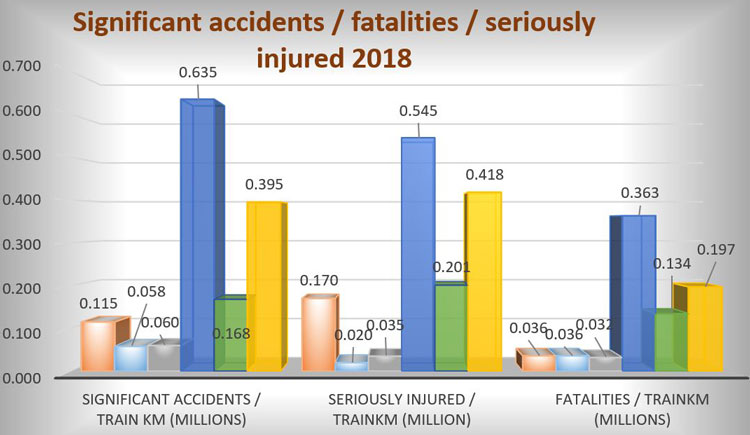

Figure 5: Significant accidents / fatalities / seriously injured 2018 (Source: ERA-ERAIL)
Suggested low-cost measures
Based on the above, it is clear there are plenty of possibilities for improvement in this area in our country, which can be achieved by adopting practices that have already been successfully implemented in EU countries. These practices and measures are not necessarily costly, while experience from their use in EU countries has shown they are very effective and can help reduce incidents in Greek level crossings.
The SAFER-LC toolbox (electronic toolbox), which includes best practices and measures implemented worldwide in level crossings, was used in order to propose the following measures. This toolbox has been developed in the framework of the SAFER-LC project by the EU, in collaboration with the UIC. Via the SAFER-LC toolbox the user enters the peculiarities of the network section of interest and receives suggestions concerning security measures for level crossings, along with useful information on cost, installation, efficiency and experience so far, resulting from the implementation of each measure. Many of the above proposed measures come from the SAFER-LC toolbox, considering the requirements and special conditions of the Greek railway network.
Taking into account the special conditions, and focusing only on low cost solutions (of less than €10,000 per level crossings), we propose the following measures, which we expect to significantly increase the security provided:
1. Awareness educational campaign
An information programme on the risks at level crossings, for primary and secondary school students, started in November 2018 and is in progress. The programme has been approved by the Ministry of Education and is implemented by RAS (Greek NSA) and OSE executives. To date, it has been presented in approximately 130 schools and to more than 20,000 students in the prefectures of Attica, Larissa, Volos, Achaia, Pieria and Pella. Positively, students easily assimilate information and transfer it to their family environment. Moreover, they are informed about railway peculiarities and dangers, thus becoming aware of how they should be careful around level crossings. The importance of continuing information should be stressed, in order for new students to be included and for the previous ones not to forget what they have learned. This measure aims at long-term results regarding safety. For the school year 2020-2021, due to the COVID-19 pandemic, a proposal has been made to the Ministry of Education to conduct the programme in a distanced learning form (synchronous learning through electronic tools); the framework for the operation of such programmes is expected to be determined by the competent Ministry.
2. Coloured pavement markings indicating level crossing danger zone
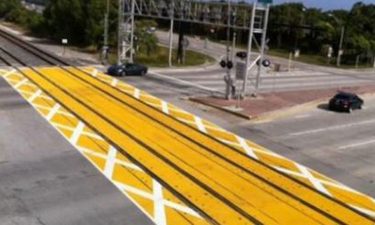

Source: https://safer-lc.eu/
This is the colouring of the level crossing surface with a bright yellow (phosphorescent) colour, so that the danger zone is indicated to level crossing users. This defines the area not to be occupied by vehicles and pedestrians, where extra attention should also be paid when a train is approaching. This is a low-cost and easy-to-apply protection measure, suitable for urban and rural areas. Although it is the easiest measure to implement, it has not been widely used in Greece.
3. Rumble strikes on approach to level crossings
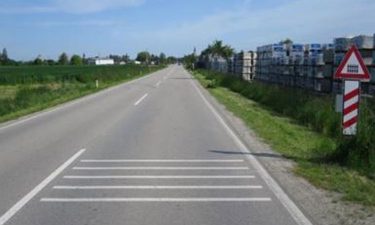

Source: https://safer-lc.eu/
Installation of vertical strikes on the road before the level crossing, producing a gentle vibration and sound for the passing car. In this way, the driver is warned and alerted when crossing a level crossing. This is a low-cost and easy-to-apply protection measure, suitable for unprotected level crossings in urban areas, which has not been implemented yet in Greece.
4. Speed bumps on approach to level crossings
Installation of special elastic structures (speed bumps) on the road before the level crossing, to reduce the speed of vehicles. This is a low-cost and easy-to-apply protection measure, suitable for unprotected level crossings in rural areas.
5. Level crossing warning light (and sound) activated on road user
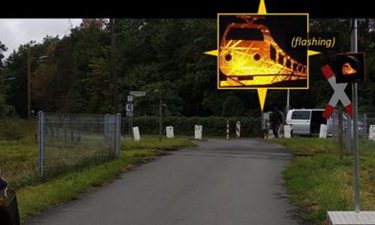

Source: https://safer-lc.eu/
Installation of a warning light for road users, which is activated by the approach of pedestrians or vehicles to the level crossing. This can be combined with an audio signal, drawing the attention of pedestrians and drivers, thus making them more focused when approaching the level crossing. This is a low-cost and easy-to-apply protection measure, suitable for unprotected level crossings in rural areas, where light and sound are more easily perceived than in urban areas.
6. Necessity study of level crossing number (especially unprotected ones)
At the initiative of the involved bodies (Ministry of Transport, Infrastructure Manager, National Safety Authority, Railway companies, local government) and with the establishment of a special committee, a necessity study regarding unprotected level crossings should be conducted, in order to rationalise/reduce their number. This will place a burden on local residents due to the forced coverage of longer distances but will contribute in a decisive manner to the limit accidents, with reduced deaths and injuries constituting an immediate benefit. Local communities (residents and municipalities) usually react to this measure.
7. In-vehicle level crossing and proximity warning
An electronic system that warns drivers via an application installed on mobile phones, first about their approach to a level crossing and second about a possible train approach to said level crossing. The installation of a GPS sensor in level crossings and on trains is required, as well as the respective installation of the application on the vehicle drivers’ mobile phones. This system has been introduced on a pilot basis in Thessaloniki, via the relevant programme ‘SAFER-LC 2019’, of the UIC in collaboration with TRAINOSE, with the installation of the application on taxi drivers’ mobiles in Thessaloniki with very encouraging results. It is recommended for use in protected and unprotected level crossings, mainly in urban areas.
We suggest the above practices and measures to ensure safety at level crossings. We believe that they can be implemented in Greece and provide both short-term and long-term benefits for railway safety.






Related topics
Related organisations
European Union Agency for Railways (ERA), Hellenic Organization for Railways (OSE), International Union of Railways (UIC)





